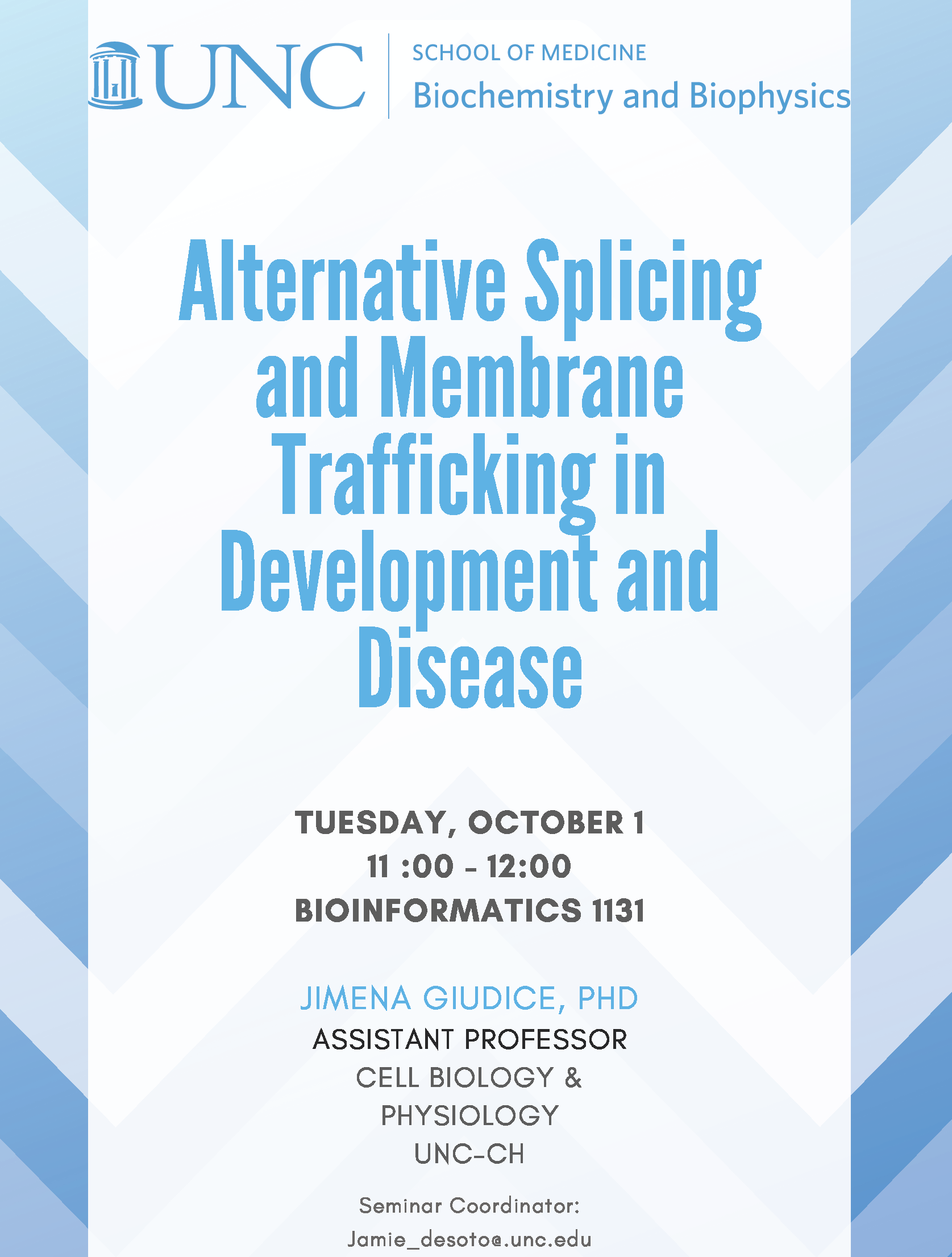
- This event has passed.
Seminar: Jimena Giudice, PhD (UNC)
October 1, 2019 @ 11:00 am - 12:00 pm

“Alternative splicing and membrane trafficking in development and disease”
Abstract: Black AJ*, Blue RE*, Engels NM1, Wiedner HJ, Hinkle ER, Giudice J
The University of North Carolina at Chapel Hill. *equal contribution
Alternative splicing is a posttranscriptional mechanism that produces multiple protein isoforms from single genes. Coordinated splicing networks regulate organ development and tissue identity1 and genes encoding trafficking proteins are highly alternatively spliced2. In particular, alternative splicing of the clathrin heavy chain (Cltc) gene regulates the expression of specific variants during striated muscle development3,4. CLTC is the main driver of clathrin mediated endocytosis; but also regulates the formation and maintenance of the costamere in skeletal muscles5. Nothing is known about the impact of CLTC splicing, leading us to hypothesize that it contributes to striated muscle physiology. We are using our new CRISPR mouse model where endogenous Cltc splicing transition is blocked: homozygous Cltc-ho mice express exclusively the short isoform throughout development while wild type Cltc-wt mice exhibit the normal splicing transitions6.
We first demonstrated that exon 31 is skipped in neonates but included in adulthood exclusively in the heart, skeletal muscles, and brain. Second, we found that the polypyrimidine tract binding protein-1 (PTBP1) and quaking (Qk) oppositely regulate Cltc splicing: PTBP1 represses exon 31 inclusion and Qk promotes its inclusion. Third, we observed that the different splice transcripts exhibit different mRNA stabilities.
Physiologically, Cltc-ho mice exhibited higher body and skeletal muscle weights than Cltc-wt littermates that is accompanied by the downregulation of myostatin expression and the AMPK-signaling pathway. Hearts are similar in basal conditions. However, after aortic constriction, Cltc-wt mice developed heart failure, cardiac hypertrophy, and plasma membrane disruption of the cardiomyocytes. In contrast, Cltc-ho littermates were protected against cardiac dysfunction and hypertrophy. In conclusion, we demonstrated that Cltc splicing is tissue- and developmental stage specific, is regulated by two specific RNA-binding proteins in opposite manners, and this regulation impacts muscle and heart biology potentially through the AMPK and myostatin signaling pathways.
[A.J.B., R.E.B contributed equally]1-Baralle, Giudice. Nat. Rev. Mol. Cell Biol. 2017
2- Blue, Curry, Engels, Lee, Giudice. J. Cell Sci. 2018
3- Giudice et al. Nat. Commun. 2014
4- Giudice et al. Cell Rep. 2016
5- Vassilopoulos, et al. J. Cell Biol. 2014
6- Blue, Koushiuk, Engels, Wiedner, Cooper, Giudice. Int. J. Biochem. Cell Biol. 2018


